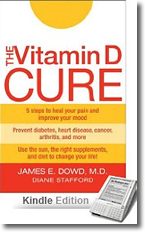Vitamin D: Cancer Prevention & Other Health Benefits
The below provides a general overview on this topic and may not apply to everyone. Any treatment protocol should be discussed with a qualified healthcare practitioner. Please refer to: Medical & Legal Disclaimer
Current government recommendations for Vitamin D intake is 400 or 600 international units (IU) of vitamin D. However, researchers from the University of California, San Diego (UCSD) School of Medicine and Creighton University (CU) School of Medicine found that when higher doses of vitamin D were taken daily, the risks associated with developing several major diseases are reduced by about half. Cedric Garland, DrPH, professor of family and preventive medicine at the UCSD Moores Cancer Center, stated as follows:
"We found that daily intakes of vitamin D by adults in the range of 4000-8000 IU are needed to maintain blood levels of vitamin D metabolites in the range needed to reduce by about half the risk of several diseases -- breast cancer, colon cancer, multiple sclerosis, and type 1 diabetes."
The Vitamin D Council (www.vitamindcouncil.org) is a nonprofit organization that focuses on educating the public and health care sectors on the importance of vitamin D and its relation to human health.
Research shows Vitamin D deficiencies are associated with:
Cardiovascular
High blood pressure, strokes and heart attack
Cancer
17 types have been identified as of this date
Autoimmune Disease
Various autoimmune conditions
Immune System & Influenza
The seasonal nature of flu may indicate that influenza is caused by vitamin D deficiency. Vitamin D regulates genes that influence our immune system to attack and destroy bacteria and viruses.
Bone & Joint Health
We need vitamin D3 to absorb calcium and phosphorous. Deficiency can lead to osteoporosis and arthritis.
Mental Health
Depression and schizophrenia
Vitamin D deficiencies may occur if...
☀️ Insufficient Sun Exposure
We don't get at least 15 minutes a day of direct sun exposure (unbroken by glass, i.e., window).
- • People in the northern hemisphere - especially during winter months
- • Those who always use sunblock or cover up against the sun
🌈 Skin Color Factor
The darker your skin, the more Vitamin D you are likely to need.
💊 Supplement Absorption Issues
Some people cannot absorb vitamin D except from the sun, tanning beds, or full spectrum lights with UVA/UVB bulbs. Others may require vitamin D injections from a doctor.
🎯 Cancer Prevention
Dr. William Grant, Ph.D. lead a study that found that about 30 percent of cancer deaths could be prevented each year with higher levels of vitamin D.
Vitamin D protects against cancer by:
- ✓ Increasing the self-destruction of mutated cells
- ✓ Reducing the spread and reproduction of cancer cells
- ✓ Reducing the growth of new blood vessels from pre-existing ones
Cancer Types That May Be Prevented:
- • Pancreatic cancer
- • Lung cancer
- • Breast cancer
- • Ovarian cancer
- • Prostate cancer
- • Colon cancers
Research Highlights:
Colorectal Cancer: High vitamin D levels can reduce risk by up to 40%
Overall Risk: Vitamin D can cut cancer risk by as much as 60%
Prevention Potential: 250,000 colorectal and 350,000 breast cancer cases could be prevented worldwide
Dr. Garland examined 25,620 blood samples and concluded that those with high blood levels of vitamin D were 70 percent less likely to develop colon cancer.
Kidney Cancer Research
A JAMA study found that eating fatty cold-water fish (high in vitamin D) at least once a week resulted in a 74% lower risk of Renal Cell Carcinoma in Swedish women over 15 years.

How to Increase Your Vitamin D Levels
Recommended Intake: The researchers recommend 2000 IU/day, plus, when weather allows, a few minutes in the sun with at least 40% of the skin exposed, for meaningful reduction in breast cancer incidence.
Sun Exposure: Moderate sun exposure with clothing and a hat when in the sun longer than 15 minutes.
Alternative: Full-spectrum lighting is recommended if natural light is not available.
Note: Excessive exposure to sunlight does not result in vitamin D3 intoxication.
🥘 Food Sources of Vitamin D
| Food | IUs per serving* | Percent DV** |
|---|---|---|
| Cod liver oil, 1 tablespoon | 1,360 | 340 |
| Salmon, cooked, 3.5 ounces | 360 | 90 |
| Mackerel, cooked, 3.5 ounces | 345 | 90 |
| Tuna fish, canned in oil, 3 ounces | 200 | 50 |
| Sardines, canned in oil, drained, 1.75 ounces | 250 | 70 |
| Milk, vitamin D-fortified, 1 cup | 98 | 25 |
| Margarine, fortified, 1 tablespoon | 60 | 15 |
| Ready-to-eat cereal, fortified, 0.75-1 cup | 40 | 10 |
| Egg, 1 whole (vitamin D in yolk) | 20 | 6 |
| Liver, beef, cooked, 3.5 ounces | 15 | 4 |
| Cheese, Swiss, 1 ounce | 12 | 4 |
*IUs = International Units
**DV = Daily Value. The DV for vitamin D is 400 IU for adults and children age 4 and older.
Foods providing 20% or more of the DV are considered high sources of a nutrient.
🌟 Other Health Benefits
🧠 Alzheimer's Disease / Memory Function
Vitamin D may mitigate free radicals in red blood cells, possibly maximizing their nutrient-carrying capacity. (Recommended dosages are usually between 200 IU to 400 IU per day - discuss with your doctor).
❤️ Heart Health
Scientists analyzed medical records from 454 men and found that those with vitamin D deficiency (15 nanograms or less per milliliter) had a higher risk of heart attack than those with sufficient vitamin D levels (30 nanograms per milliliter or more).

🦴 Arthritis & Joint Health
Laboratory research shows that cod liver oil can not only treat arthritis, but actually reverse damage. Dr. James Dowd at the Arthritis Institute of Michigan has been prescribing vitamin D for chronic disorders with significant improvement in symptoms.
The Vitamin D Cure - Dr. Dowd's five-step program can eliminate or alleviate conditions like arthritis in as little as six weeks.
🦷 Dental Health
Secondary dentine production can "heal" decayed spots when vitamin D is adequate. Calcium content of saliva doubled or tripled when the diet contained adequate vitamin D from cod liver oil.
🤧 Flu / Common Cold Prevention
A theory explains flu epidemics as a result of vitamin D deficiency. This would explain why flu epidemics occur when vitamin D-producing sunlight is reduced by winter. Research found that 2,000 IU of vitamin D per day abolished the seasonality of influenza.
Action: Spend at least 15 minutes outside daily in summer, and consider 5,000 IU D3 supplements during winter, spring, and fall (discuss with your doctor).
🦵 Muscle & Knee Health
Research linked higher vitamin D levels to improved muscle strength and function in the knee, with benefits for osteoarthritis symptoms.